If Aggretsuko was a sapphic werewolf horror, you'd get Bitemark
Spoiler-free review of Bitemark by Michael Stinson and Devan Muse
Today I’m reviewing “Bitemark,” a horror OEL manga written by Michael Stinson and illustrated by Devan Muse. The complete graphic novel is available on Globalcomix. A free copy of the graphic novel was provided for review (I’m putting that at the top of the post, because it’s exciting I get to say that).
Official summary:
Life as a corporate drone couldn’t kill Miki – but this might. Our story opens in 2023 in an east coast city where a mysterious beast has hunted for the better part of a decade. Following in the tradition of classic horror tales like An American Werewolf in London, Ginger Snaps, and The Howling, Bitemark is our take on werewolf lore. Although treated like a curse by some, lycanthropy is a superpower—a means to reinvent the identity of our protagonist through bestial strength and instilling fear at just a glance of the furry mutated form. This blood-shedding power is tempting to a timid office drone like the protagonist, Miki, who is trampled upon by her A-Type coworkers.
Part 1: This is a solid entry point
If you’ve never read an OEL manga, “Bitemark” is a fantastic place to start. I absolutely love what I read, and would be eager to nominate it as an ambassador for OEL manga.
OEL manga is an interesting place. I go to it because it’s offering a different perspective. They’re uniquely different from Japanese-grown manga, and in a completely different universe from the stuff influenced by (or made in opposition to) mainstream Anglosphere or Franco-Belgian comics. It’s mostly indie, a little rough, but wholly different.
Which means it’s difficult to recommend. Most OEL manga is self-published, so that comes with the same quirks as webcomic publishing. There’s plenty of authors abandoning their series, slow updates, and getting to a Volume 1 may take years. I see it as a perfectly reasonable trade-off - getting a look into this niche outsider art means not all of it will have the steam to execute their complete vision. That sucks but it’s part of the deal.
So I was delighted to find Bitemark. The author reached out for a review and provided a copy of their work - it wasn’t a Chapter 1, no “here’s my idea,” he slapped a whole-ass graphic novel on my desk. And Bitemark is a complete story - I forgot which manga editor/gymnastics coach said it, but starting a story is easy, sticking the landing is the hard part. And this is a story with an incredibly satisfying ending.
Other than just being an OEL that tells a complete story, I’m also voting for it to be an OEL ambassador because it hits a lot of the bigger tropes of OEL manga:
The art is unquestionably manga-shaped, but lacks the refinement found in professional Japanese manga
The story seems heavily influenced by tropes and storytelling conventions outside of manga (“Bitemark” defines itself in the afterword as a “cabin horror.” It feels like it’s shaped more by “Save The Cat” than “The Shonen Jump Guide to Making Manga”)
The protagonist is a woman of color and it’s not afraid to touch on oppression
This felt like an indie horror movie delivered in manga form, which is why I could see this breaking past an audience of just OEL manga readers.
Part 2: Is it gay?
Odds are, your gaydar is better than mine, since I left mine at a Gamestop to get it repaired and still haven’t picked it up.
I’m not sure what’s the authorial intent in Bitemark, but I also don’t think that it entirely matters. If you like the Yuri Feels, you’ll like the interactions between the two female protagonists. If you’re a little more oldschool, you could see this as just Two Gals, Being Pals.
The afterword left me more confused:
Coming of age stories and films like Adventureland and Blue is the Warmest Color influenced the major themes in Bitemark. These stories of young individuals growing into themselves showed me that our experiences during our adolescence are just one chapter of our lives. A phrase that I read somewhere (though I can't remember the source) went along the lines of "a profound friendship between two women is like a romantic relationship." With this subversive concept in mind, we built the relationship between Miki and Ana.
Subversive is right. Things constantly feel kinda gay between protagonist Miki and her coworker Ana, but I’m not sure if this is just reflective of how women can be a little more touchy-feely with each other, or if exclusively reading light novels inebriated my critical thinking skills. (If it matters: This story was not tagged as LGBTQ on Globalcomix).
But what’s thoroughly pleasant is that I don’t feel like I’m being queerbaited, shipteased, or deceived. I also don’t feel like this was done to meet a quota or as a marketing ploy - that is, I can’t see this being written to parade around the protagonist as Shonen Manga’s First Black Lesbian Protagonist. These character interactions unfold very naturally, to the point where it feels incidental if it’s “supposed” to be gay.
A lot of guys rolling their eyes over “woke” storytelling will swear they don’t care about if a character’s a lesbian, they just want a good story, that we’d all be happier if characters could just be gay without it being their whole personality.
And on the other side of the fence we’ll see guys in the LGBTQ community saying they’re sick of gay characters having one (1) throwaway line to confirm their queerness. Like that was cool when they did it in Paranorman, but that movie’s ancient now, and it’d be nice to have gay characters that show their gayness in ways that can’t be edited out for a release in China.
I know these are false equivalents, since the former is usually annoyed by adult-orientated shows on Netflix and the latter is annoyed by the shit Disney’s churning out on its factory line. But if I could use one of my monkey’s paw wishes to make these two strawmen into a real boy, they’d both agree that “Bitemark” does it right.
Part 3: This manga will hit good for Aggretsuko fans
There’s some superficial comparisons to be made between Bitemark and Aggretsuko. Both protagonists are meek office ladies, they get pushed around at work, their boss is a misogynistic creep. But that’s all window dressing for why this felt so much like Aggretsuko.
Aggretsuko is a kickass show, one of the many reasons being that it articulated an incredibly specific feeling of young-adult ennui. And at its core, Bitemark also addresses a similar ennui, along with a more pronounced social and existential anxiety. Much like Aggretsuko, Bitemark addresses this issue in a way that’s incredibly thoughtful and sincere, without ever getting too sappy or melodramatic.
Disclaimer that I haven’t watched the final season of Aggretsuko (I am not Ready), and it ranks as one of my most rewatched animes.
But I know Aggretsuko is not perfect (because if it was, we’d have Haida/Tadano/Himuro as a polycule). Common 1-star reviews include: the plot spins its wheels, the characters go nowhere, why doesn’t Retsuko quit her job, Fenneko is underutilized, why is Haida such a little bitch, why doesn’t Ton, the largest of the office, simply eat the others. They’re all fair critiques but they’ve never dragged down my viewing experience, because Aggretusko as a complete package gives me something I can’t find anywhere else.
Bitemark doesn’t have a lot of these same issues, and approaches its problem of ennui in a very different, less Japanese, way.
If we’re just comparing the emotional core of both stories, there’s one pretty big difference. Aggretsuko as a series plays a lot with the honne/tatemae duality - the concept that a person’s true feelings are different from what they show to the world. Much of Aggretsuko relies on changes in perspective for plot development. So in that sense, it’s less about a concrete “character development” and more about revealing different sides of its characters, so the audience can be keyed into the bigger picture (In other words, I forgive any one-star review that may have missed this cultural nuance).
Bitemark is more concerned with bridging the gap between internal/external modes of expression. In that sense, it felt a lot more American in its approach to the same problem. It was remarkable how much the Bitemark’s protagonists anxieties reminded me of Retsuko - so if you found yourself sick to tears with Retsuko’s bootlicker shoganai attitude, Bitemark is the dream rewrite you’ve been looking for.
Part 4: The art
I completely forgot to talk about the art.
Which is funny because I usually have a lot more to say about a manga’s visual delivery. This is a rare instance where the writing was so captivating, it took me a minute to become attuned to what’s visually happening. But I don’t want to dismiss the art completely.
There’s something very unassuming about this manga’s visual design, which made it all the more surprising when the supernatural horror elements kicked in. And it was definitely able to deliver on the more gruesome scenes.
So for the purposes of telling its story, it definitely works.
However.
This manga is held back by weak anatomy. This is not something I say lightly, since I strongly advocate style over substance. And before I dig in too hard, let me say what I really loved about Bitemark’s art:
Screentone usage is creative, but very tidy
Page layouts are thoughtful. There’s a good variety in the types of pages and panel layouts, but never any confusion over how to read the page
The staging of each scene is careful and dynamic
Overall strong pacing
It’s a manga that has a professional-level polish in every area except anatomy. This style feels like it’s someone who jumped into making manga before learning the fundies, and kept themselves propelled by their sheer love of manga.
I say this because that’s been my attitude when it comes to mangamaking. So I might be off base and just, like, projecting- but if I had to guess, that’s how you get an art style like we see in Bitemark. And this mindset is not at all uncommon, especially with OEL and webcomic guys. There’s a reason why I started this post saying Bitemark would work as a solid OEL ambassador. For better or worse, this is something that pops up a lot in this world.
I’d like to bring to the stand the mangaka One. He’s used as a common shorthand for the sentiment that “you don’t need technical proficiency to make a good manga.” He wasn’t the first/only, but right now he’s the most notable. Part of his appeal is the crazy, dynamic action. When the proverbial camera’s being whipped around on a string, that dynamic action can compensate for the crudeness of the character art.
The issue with Bitemark is it’s not crazy enough to justify the rougher character art. And that’s not to say “make it flashier!” It’s a cabin horror story - and the mise en scéne was expertly handled. It’s also not so bad it’s distracting or laughable, unless you really want to be a jackass and nitpick panel-by-panel.
This is an artist with a unique vision and style. So I won’t even say “maybe next manga they’ll ramp up The Action!” They don’t need that. At all. Whatever masters of old they studied to understand pacing and staging definitely worked, and they shouldn’t feel like they have to mold their style into something it’s not. If there’s any chance the artist reads this, I would beg them to study anatomy, do gesture studies, anything to make your characters feel more grounded. This is an artist who’s just on the cusp of greatness. They understand all of the intrinsic pieces of mangamaking you can’t just sit down and grind out with practice. So now’s the time to ramp up the practice.
Part 5: What Do We Have To Do to Get This a Live Action Adaptation
This is a story that could easily work as a short film. It’s cheaper to make a comic, sure - but the entire reading experience felt very cinematic.
I will say one unique benefit of this being delivered as a manga first has to be that the initial trust between Miki and Ana feels easier to believe.
When we’re introduced to Ana, we see she’s boldly decorated her desk with waifu figures that border on inapropriate for a workplace. I love it! I’m reading this manga because I like manga - so I find it easy to accept that the chick with anime figures is a Good Guy who would stick up for the socially anxious protagonist. It’s half reader-wish-fulfillment and half playing with the reader’s meta understanding of otaku culture. But this shortcut to trusting Ana might be lost in another medium.
Part 6: Description confusion
Many of my OEL manga reviews involve some degree of both huffing and puffing over their official description. And I’ve yet to learn my lesson, so here I go again.
But the official description for this absolutely blows. Let me post it again so you don’t have to scroll back up to see what I’m talking about:
Life as a corporate drone couldn’t kill Miki – but this might. Our story opens in 2023 in an east coast city where a mysterious beast has hunted for the better part of a decade. Following in the tradition of classic horror tales like An American Werewolf in London, Ginger Snaps, and The Howling, Bitemark is our take on werewolf lore. Although treated like a curse by some, lycanthropy is a superpower—a means to reinvent the identity of our protagonist through bestial strength and instilling fear at just a glance of the furry mutated form. This blood-shedding power is tempting to a timid office drone like the protagonist, Miki, who is trampled upon by her A-Type coworkers.
It’s a bit clumsy, too long, definitely awkward. Which is bizarre, since this was such an air-tight script. I know this was published under Lucha Comics, so maybe an unrelated marketing director/editor is responsible for their word salad description. Or maybe the author just saw his confidence evaporate when writing the description - it happens to the best of us.
I’m not familiar with any of the media referenced in the official description- sorry, maybe they’re all really big and that’s the audience they’re trying to court, and I’m the culturally unaware dipshit. And describing Miki’s office bullies as “A-type coworkers” is… Wrong? They’re typical mean girls, unless “A-type” has another meaning I’m not getting. Ending the summary with the tidbit about her coworkers is kind of strange - since they’re just sort of obstacles for Miki to overcome, and she has an overarching social anxiety that extends beyond the office. I’d also argue that her Old Man Misogynist Boss is a bigger issue at work, since he has tangible power over her.
Here’s my attempt at a 2-sentence summary:
Miki’s mundane life as a timid office drone is defined by her anxieties and existential ennui, making her feel insignificant and lost in the world. Her life takes an unexpected turn when her outgoing and confident coworker reveals the hidden world of lycanthropy, offering Miki a chance to transform her life.
I’m not a professional Description Guy, so I’d encourage more attempts/riffing from what I provided (that is, if over at Lucha Comics they have an annual Spring Cleaning Event where they tidy up product descriptions). This was a fantastic, memorable story - ignore what they wrote in the description. Their sales pitch doesn’t do it justice.
You can read Bitemark on Globalcomix
Copyright Disclaimer: Under Section 107 of the Copyright Act 1976, allowance is made for "fair use" for purposes such as criticism, comment, news reporting, teaching, scholarship, and research. Fair use is a use permitted by copyright statute that might otherwise be infringing. Non-profit, educational or personal use tips the balance in favor of fair use. I’m not trying to be an art theif, just a critic. Pls no bulli.
Pride parade photo by Photo by Norbu GYACHUNG on Unsplash.If you’re the creator of an indie comic/manga and you’d like me to review it, leave a comment and we’ll talk 🫶
Thank you for reading!


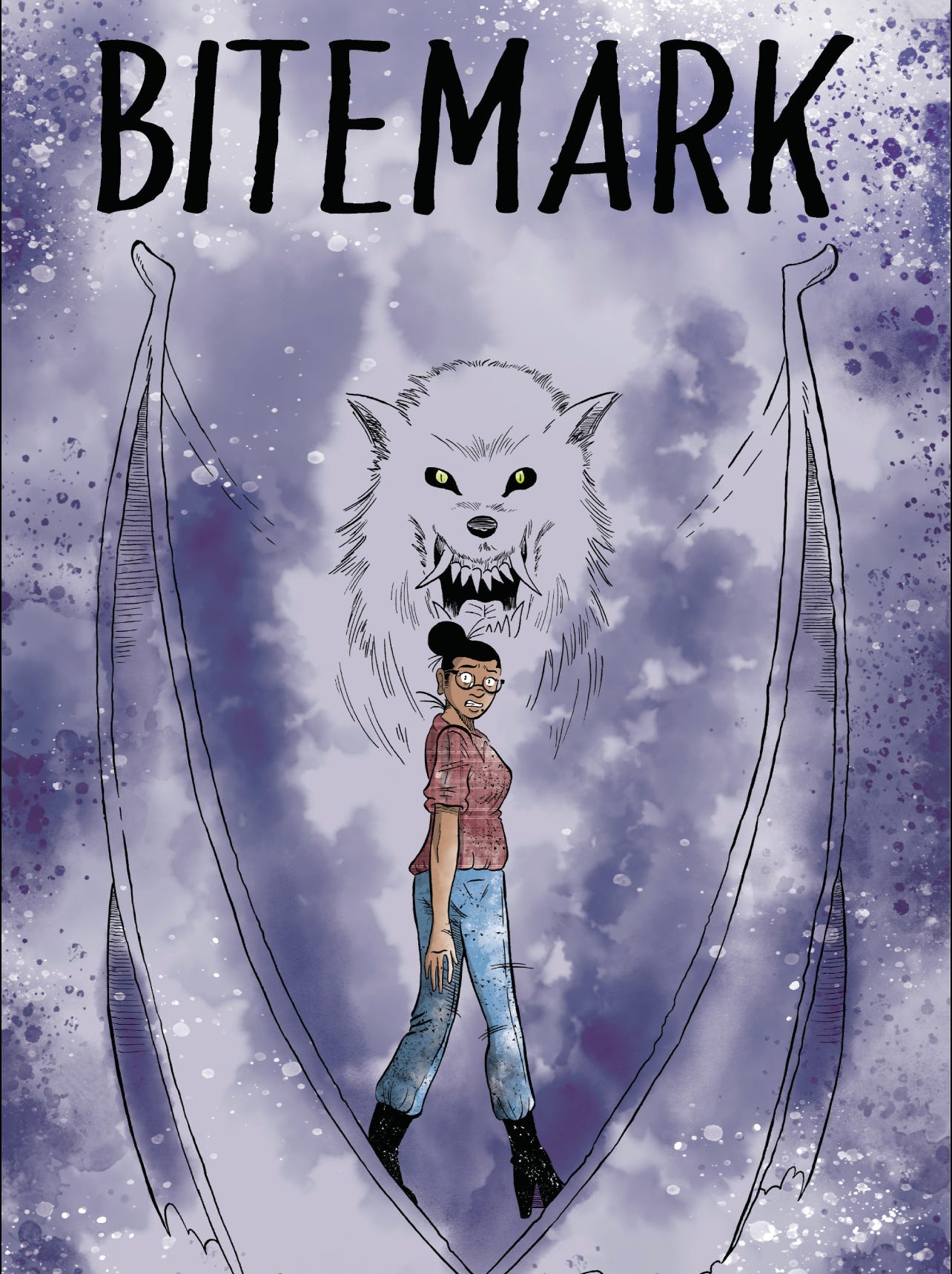

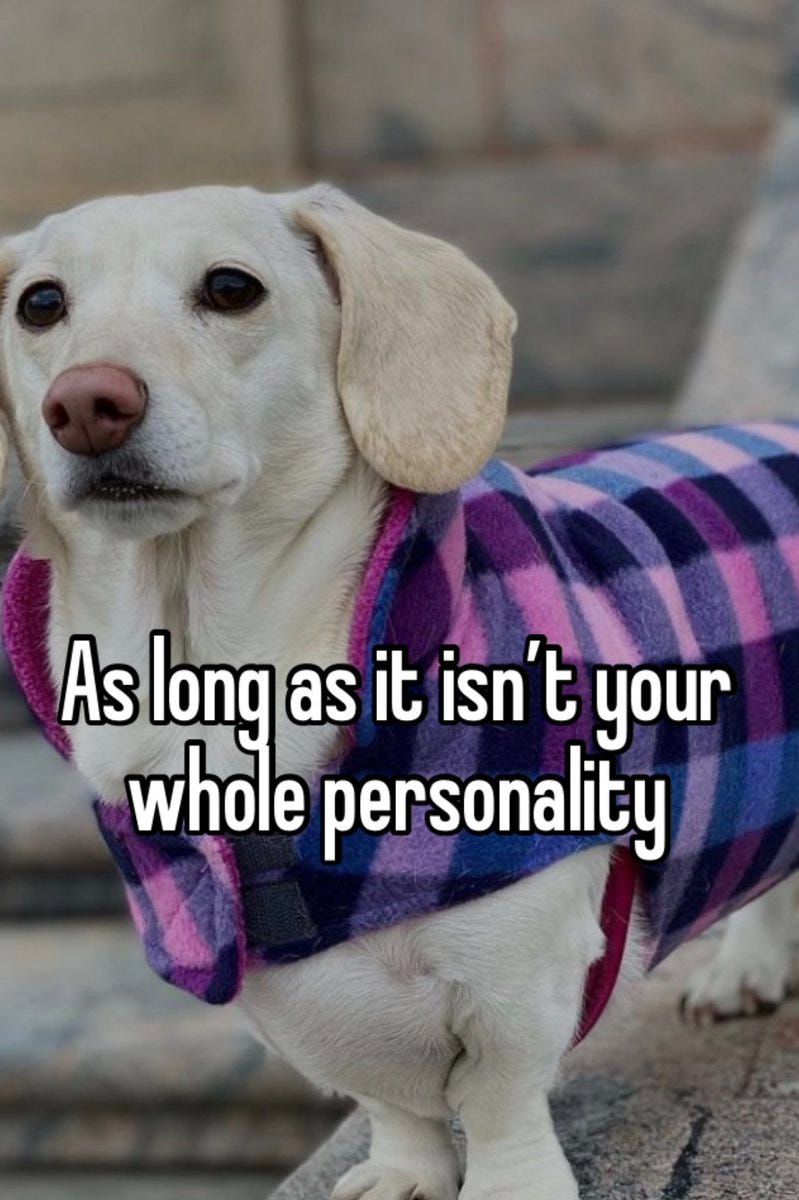
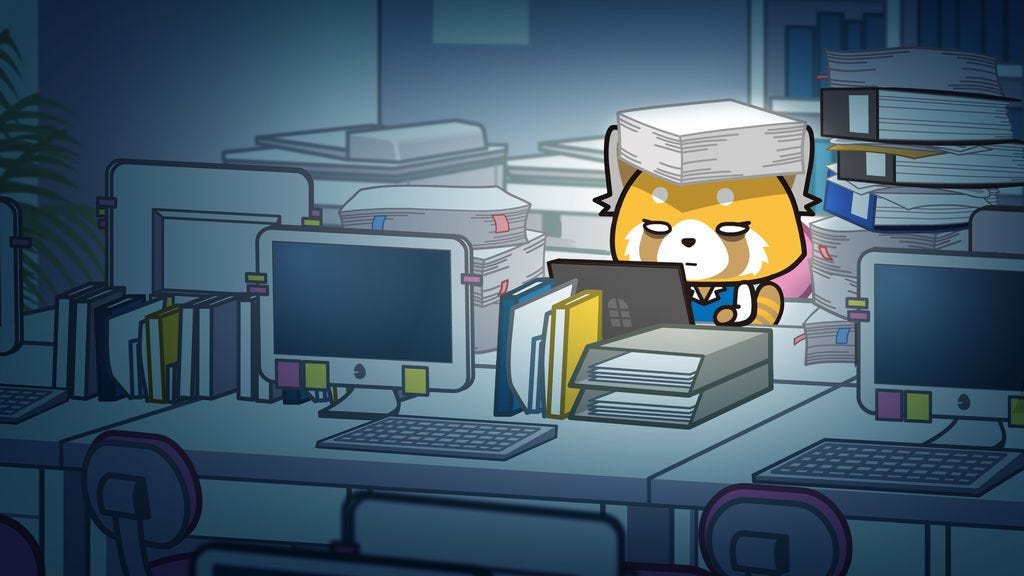
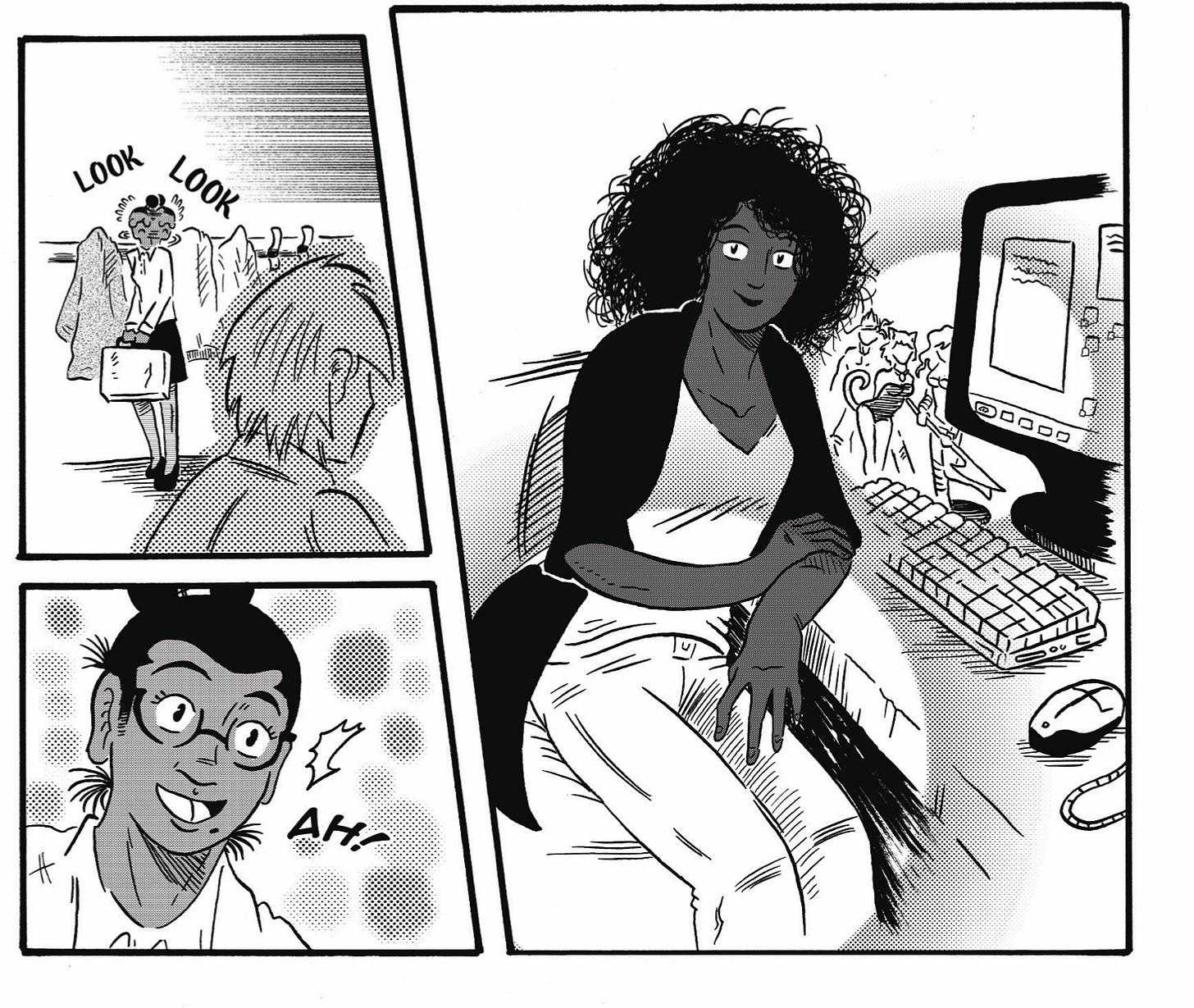
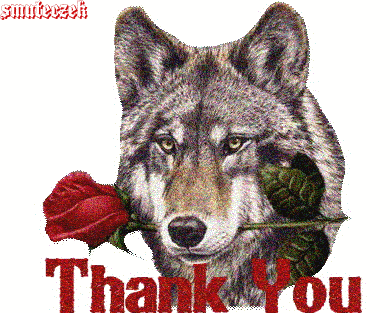
I've only fairly recently found out about "OEL" manga and wondered what actually makes manga, manga, and not just comics. Is it the aesthetic? the use of KiShoTenKetsu? the country that it's made? What. Some oel resemble manga more in its presentation than others I've found but, and it's usually just the creator telling you that it's manga. I guess it's up to the individual to decide; comics are comics. While writing my light novel I came upon this quandary thinking to myself what is it that makes it a light novel? why am I calling it that and not just a y.a novel and my reasoning is that I wanted the manga aesthetic, and imagery projected into the readers minds. I don't know if I'm right in that but that's what I settled on.
What a great, in-depth review. For the record, I absolutely love this comic.